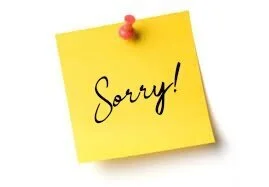How the Best Leaders Say Sorry
Could the key to increasing “employee engagement” be reducing “employee estrangement”?
As a CEO Coach to CEOs and Executive Teams, how to craft powerful apologies is one of the simple leadership skills I teach top leaders.
The humble apology is a powerful instrument, but it’s often neglected by leaders. Large corporations spend millions training people in communication skills and conflict management, but they rarely spend a dime teaching leaders how to say they’re sorry.
In so many companies, there are coworkers, business partners, and team members who no longer get along. They can’t even be in the same room together because of lingering resentment from things that were said or done in the past.
When I think about all of these broken professional relationships, I am reminded of the day I discovered the Japanese art of kintsugi.
Invented in the 15th century, kintsugi is a technique for repairing broken pottery using a special lacquer mixed with gold, silver, or platinum to put the pieces back together. What struck me as most interesting, was the way the artist visibly incorporates the repair into the design, rather than attempting to disguise it. The repaired piece is often transformed into something even more beautiful than the original.
What a great metaphor for relationships! How do we mend broken business relationships, in a way that they become stronger and more beautiful than the original?
With an apology.
But, an artful apology is not just a nonchalant word said passing in the halls or a post-it note placed on a monitor saying “Sorry”
An artful apology includes 5 specific things according to Gary Chapman’s Five Apology Languages:
EXPRESS REGRET
We tell children, “Say you’re sorry.” Words matter, so your apology needs to sound genuine. To do that, you need to make sure you actually are sorry. If not, dig a little deeper into your blind spots. An ideal apology includes an expression of genuine regret, but if you can’t get there emotionally, you can at least accept full responsibility for what you did. That’s the next best thing.
ACCEPT RESPONSIBILITY
It’s also important that we accept responsibility for our actions. For many, it’s important to hear that the person who hurt us also says, “I was wrong and I take full responsibility for my actions.” When my children hit each other in the car, and I tell them to say sorry, their response is often, “But he hit me first!” To this, I calmly respond, “If a person hits us, we still have a choice whether to hit back. If we choose to hit back, we are 100% responsible for our decision to hit back.” Said another way, “Two wrongs don’t make it right.”
If the other person is not prepared to take full responsibility for their actions, how can we trust that they will change in the future? Which brings us to the next element of an artful apology.
COMMIT TO CHANGE
If you apologize without genuinely committing to change, the other person will think, “You say you’re sorry and want to change, but time will tell. I’ll believe it when I see it.”
A believable commitment to change includes up to three things: 1) a list of behaviors that one will start doing, 2) a list of behaviors that one will stop doing, and 3) a date by which this will happen (or a time at which we will talk about it again).
For example, “I’m sorry for arriving late to our meeting. I am going to ask my assistant to change my schedule to add 15 minutes between meetings. I am putting a reminder into my phone as we speak for 8 weeks from today to check in with you and confirm that I am honoring my commitment to you.”
MAKE AMENDS
Once we’ve expressed regret, it’s also important to communicate how we will make it up to the person that we hurt. Make it clear that you are willing to put some effort into mending the relationship.
It lends credibility and weight to your apology if you have already prepared a handful of suggestions to how you can make it up to the person. But if you don’t know the best way to make amends, just ask, “How can I make it up to you?”
If the person shrugs it off, consider asking, “Would it be OK if I think about it for a couple days and come back to you with a couple suggestions of how I can make it up to you?”
This really shows the person that you care.
REQUEST FORGIVENESS
This is the final element of an apology, and it’s also the most powerful. After expressing regret and taking full responsibility for what you’ve done, offering to make amends, committing to make a change, it’s time to ask, “Will you forgive me for hurting you?”
Here’s the hard part.
Too often, people say the words, “I forgive you” … but they actually haven’t.
If you’ve really wronged someone, it’s very likely that the person is not ready to forgive you. And it’s important that you leave the door open for that.
Here’s a suggestion of how to leave the door open for someone who isn’t ready to forgive, “I understand if you aren’t ready to forgive me. And if you aren’t, I also want you to know that’s OK. It’s understandable that you may want to see that I’ve acted upon my commitment to change or made amends before you forgive me.”
If you sense that the person is pausing, then they likely are not ready to forgive you… yet.
If that’s the case, here’s how to follow up:
“I understand. Can I follow up with you in 4 weeks to ask you again to forgive me after I’ve demonstrated my commitment to change and make amends?”
THE BEAUTY OF KINTSUGI IS IN THE EYE OF THE BEHOLDER
Every person places different value on each of the 5 elements of an apology. For some, the commitment to change is the most important. For others, it’s making amends.
Luckily, there’s a quiz that you can use to learn what types of apologies work best for you, and for the people around you. Subscribe to the blog and I’ll email you the quiz.
APOLOGY VS FORGIVENESS
Now, asking for forgiveness is different from granting forgiveness. Sometimes the person we need to forgive is ourselves. But we will cover “Why Forgiveness Belongs in Business” in a couple weeks. Subscribe and I will email it to you automatically.
Tags: ceo coach, leadership, employee engagement


